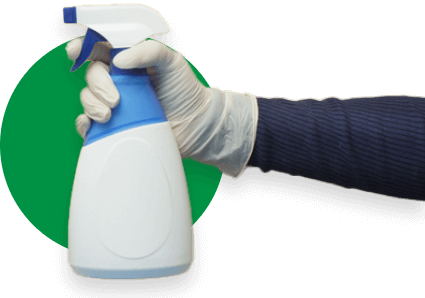Your office does more than just house your business—it sets the tone for productivity, health, and first impressions. Maintaining a clean, organized workspace in bustling areas like Dallas-Fort Worth or Arlington isn’t just about appearances; it’s about creating an environment where employees thrive and clients feel confident. Let’s uncover how professional cleaning services are key to keeping your workspace inviting and efficient.
Why a Clean Office Matters More Than You Think
It’s easy to overlook the importance of a clean office when deadlines loom and meetings fill calendars. However, the cleanliness of your workspace impacts much more than just its aesthetic appeal—it’s directly linked to your team’s health and productivity. A clean office projects professionalism and creates an environment conducive to productivity and wellness.
Maintaining a sanitary workspace is crucial in bustling urban areas like Dallas, Arlington, Fort Worth, and Denton, where business pace is fast and office density is high. Let’s delve into the unseen benefits of a clean office and why it should be at the top of every business’s priority list.
The Hidden Costs of an Unclean Workspace
A clean office goes beyond aesthetics—it’s about safety. Did you know the average desk can harbor over 10 million bacteria, 400 times more than a toilet seat? In high-traffic landmarks like the Bank of America Plaza in Dallas or Frost Tower in Fort Worth, germs can spread exponentially, leading to a rise in sick days and a drop in productivity.
Health and Safety First
Microbes such as norovirus, influenza, and E. coli are frequent unwelcome visitors to offices. Regular professional cleaning becomes essential to mitigate these health risks, particularly during changing seasons in cities like Denton and Arlington.
Why Choose Dallas Janitorial Services?
Choosing an exemplary janitorial service is crucial for maintaining a high standard of cleanliness and professionalism in your office. With numerous options available, selecting a provider that understands your locale’s unique challenges and has a proven track record of exceptional service is essential.
Dallas Janitorial Services stands out in the North Texas market. We offer not just cleaning but also a commitment to creating healthier workspaces. Here are reasons why partnering with us could be the best decision for your business’s cleanliness and health standards.
Local Expertise You Can Trust
As part of the North Texas community, Dallas Janitorial Services understands the specific needs of local businesses. Our customized approach ensures that your office receives optimal cleaning services, whether near the bustling Sundance Square in Fort Worth or a quiet suburb in Arlington.
Tailored Cleaning Plans for Every Business
Our services are designed to meet your office’s unique needs, considering factors like location, size, and industry specifics. This bespoke approach ensures your workspace looks its best and maintains a professional image and healthy environment.
Essential Office Cleaning Best Practices
Effective cleaning routines are essential for creating a healthy and efficient workplace. Maintaining a meticulously clean office in dynamic business hubs like Dallas is necessary for the well-being and productivity of everyone who steps through your doors. You can ensure a workspace that promotes physical health and mental clarity by following proven office cleaning best practices.
At Dallas Janitorial Services, we understand the nuances of keeping your environment pristine. In this section, we’ll explore the protocols that form the backbone of our cleaning services, ensuring your office looks its best and supports peak performance and hygiene.
Daily Tasks for a Cleaner Workspace
Consistency is key to maintaining a clean office environment. Our daily cleaning checklist includes several critical tasks:
- Surface Disinfection: All high-touch surfaces, such as doorknobs, light switches, and elevator buttons, are disinfected multiple times throughout the day to prevent the spread of germs.
- Trash Removal: Trash bins are emptied and sanitized daily to avoid odors and maintain a hygienic environment.
- Floor Care: Floors are swept, vacuumed, or mopped daily to remove dirt and debris, which helps preserve their condition and prevents the accumulation of allergens.
- Restroom Maintenance: Restrooms are cleaned daily to remain sanitary and stocked with necessary supplies like soap and paper.
Weekly and Monthly Cleaning Must-Dos
While daily cleaning focuses on maintaining a baseline of cleanliness, deeper cleaning tasks are scheduled on a weekly or monthly basis to address areas that require more intensive care:
- Deep Carpet Cleaning: Carpets trap dust and allergens and can become breeding grounds for bacteria. We perform deep carpet cleaning using hot water extraction techniques to extend the life of your carpets and ensure they are hygienically clean.
- Window Washing: Clean windows enhance the aesthetic appeal of your office and improve natural lighting. Our teams clean interior and exterior window surfaces monthly to keep them streak-free and clear.
- Air Duct Cleaning: To help ensure the indoor air quality of your business, our janitorial services include cleaning air vents and ducts to remove dust and allergens that accumulate over time. You can expect air ducts to be cleaned on a quarterly schedule.
- Upholstery Cleaning: Office furniture is also prone to dirt and stains. We clean upholstery regularly to maintain its appearance and hygiene.
Seasonal Cleaning Tips for Dallas Offices
The changing Texas seasons bring different challenges, from spring pollen to winter flu viruses. Our seasonal cleaning adjusts to these variations to provide targeted cleaning that addresses specific seasonal concerns:
- Allergy Season Prep: Before allergy season begins, we eliminate allergens from the office environment through thorough dusting and frequent air filter changes.
- Flu Season Rigor: During flu season, our focus shifts to increasing the frequency of disinfection, particularly in communal areas like kitchens and meeting rooms.
- Weather-Related Cleaning: Rainy seasons and winter months may require additional matting at entrances and enhanced floor care to manage moisture and mud.
These essential cleaning practices ensure that your office looks clean and promotes a healthy and productive environment. By adhering to these standards, Dallas commercial janitorial companies can help your business maintain a professional image and provide a workspace conducive to success.
Spotlight: Areas That Demand Extra Attention
While every corner of your office deserves a thorough clean, certain areas require extra vigilance due to their frequent use and high risk of germ transmission. Dallas Janitorial Services prioritizes these zones, ensuring they are clean, hygienic, and safe for everyone with our high-standard sanitation services in Dallas. Let’s delve into the specific areas within your office that demand special attention and our expert approach to maintaining them at the highest standards of cleanliness.
Workstations and Desks
Workstations and desks are the epicenters of daily activity and can harbor a surprising amount of bacteria and viruses due to constant use. Regularly cleaning high-touch areas like keyboards, mice, and phone receivers is crucial, especially in shared spaces typical of downtown office buildings. We use EPA-approved disinfectants to ensure effective cleaning for a healthier workplace. These surfaces are visibly clean and germ-free, reducing the risk of illness spreading within the office.
Kitchens and Break Rooms
Kitchens and break rooms are communal spaces with heavy foot traffic. They are common areas for employees to gather and share meals. Maintaining these spaces with the highest cleanliness standards will help prevent foodborne illnesses and ensure a pleasant resting environment. Surfaces, appliances, and cabinets are cleaned daily, while refrigerators and microwaves are cleaned deeper weekly to avoid the buildup of grime and bacteria. All cleaning agents used are food-safe, ensuring no harmful residues are left behind.
Restrooms
Restrooms are critical areas that can affect your office’s overall health environment and impression. Our comprehensive cleaning practices ensure restrooms are clean and sanitized, reflecting your business’s professionalism. This includes disinfecting all surfaces, from toilet seats to faucet handles, and restocking hygiene supplies like soap and paper products to ensure they are always available. The floors are also treated with germicidal cleaners to eliminate any pathogens that might be present.
Entryways and Reception Areas
These areas are the first point of contact for anyone entering your office and play a key role in setting the right impression. We ensure that entryways and reception areas are immaculate, regularly cleaning door handles, reception desks, and seating areas. Floors are vacuumed or mopped multiple times throughout the day, and mats are cleaned periodically to prevent dirt from tracking further into the office.
Conference Rooms
Conference rooms require special attention due to their varied use and the importance of maintaining a professional meeting environment. Surfaces like conference tables, chair arms, and AV equipment are sanitized before and after each use. Regular window cleaning ensures natural light can enhance the room’s ambiance, making it a welcoming space for both employees and guests.
By focusing on these critical areas, Dallas Janitorial Services ensures that your professional office is clean, safe, and inviting for everyone. Our targeted approach helps minimize health risks and enhance the workplace experience, making it an ideal setting for productivity and professional growth.
The Dallas Janitorial Difference: A Behind-the-Scenes Look
At Dallas Janitorial Services, our commitment to excellence is deeply embedded in our use of cutting-edge technology and sustainable cleaning practices. We believe in providing a superior cleaning service that meets and exceeds industry standards while caring for the environment. Here’s a closer look at how our dedication to quality and sustainability sets us apart:
Advanced Cleaning Technologies
We utilize the latest advancements in cleaning technology, including electrostatic sprayers for disinfecting surfaces, HEPA filter vacuums for improved air quality, and ultraviolet light treatments to eliminate pathogens effectively. These tools allow us to provide a thorough, efficient, and effective cleaning, ensuring no detail is overlooked.
Eco-Friendly Practices
Sustainability is at the core of our operations. We use environmentally friendly cleaning products that are powerful against dirt and grime but gentle on the planet. These products are carefully selected to reduce harmful chemicals in the environment without compromising on cleanliness. Additionally, we implement water-saving techniques and waste-reduction strategies to minimize our ecological footprint.
Trained and Skilled Staff
Our team comprises highly trained professionals who understand the nuances of professional cleaning. Regular training sessions update them on the latest cleaning techniques and safety protocols, ensuring they are prepared to handle any cleaning challenge—this commitment to professional development results in a consistently high-quality service for our clients.
Transparent Communication
Good communication is key to successful cleaning services. Our clients are informed at every step of the process, receiving regular updates and reports on the cleaning status. This transparency builds trust and ensures that any concerns are addressed promptly, leading to better service and client satisfaction.
How to Get Started with Dallas Janitorial Services
Embarking on a professional cleaning journey with Dallas Janitorial Services begins with understanding your needs. We recognize that every office space is unique, and our goal is to provide personalized service that perfectly aligns with your requirements. Here’s how you can get started with us:
Custom Cleaning Plans Made Easy
We start our process with a free consultation, which allows us to assess your unique needs in detail. During this consultation, we discuss your office’s specific cleaning requirements, frequency of service, and any particular challenges you face. Whether your office is located in the bustling downtown of Dallas or the quieter streets of Denton, we tailor our services to match the specific characteristics of your environment.
Flexible Scheduling
Understanding that business operations vary, we offer flexible scheduling options to fit your office’s hours and peak times. This flexibility ensures that our cleaning services are provided at the most convenient times, minimizing disruption to your daily activities.
Seamless Integration
Once a plan is in place, our team works seamlessly with yours to integrate our services into your daily operations without interruption. We equip our staff with everything they need to complete the job, from advanced cleaning products to detailed checklists.
Ongoing Support and Cleaning Service Adjustments
As your business evolves, so might your cleaning needs. We offer ongoing support and are ready to adjust our services as required to ensure your office continues to benefit from the highest standards of cleanliness.
Request Your Free Consultation Today
It’s time to transform your workspace into a spotless, productive environment. Schedule your free consultation today and see the difference professional cleaning can make.
Keep your office pristine and professional—contact Dallas Janitorial Services now to create a cleaner, healthier workspace.







